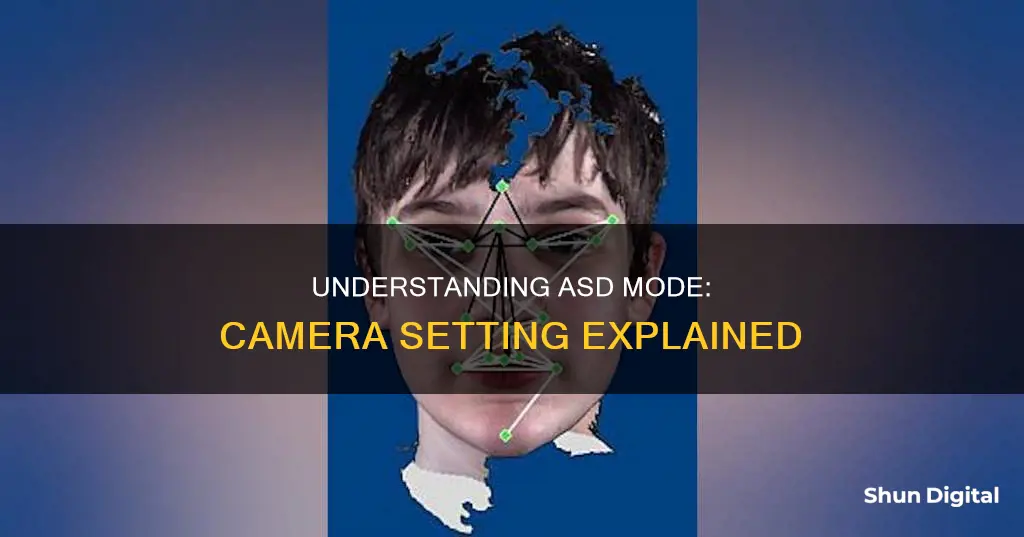
ASD, or Auto Scene Detection, is a mode in which your phone's camera will determine the scene mode that the picture requires. Scene modes may override flash and other settings. For example, if you are taking a photo of a landscape, you might want to use the infinity setting, which fixes the focus on far-away objects. ASD mode is useful when you don't have the time to adjust your camera settings manually, but it can also take away creative freedom and result in lower-quality images.
| Characteristics | Values |
|---|---|
| ASD Mode | Auto Scene Detection |
| ASD Mode Function | The phone's camera determines the scene mode the picture requires |
What You'll Learn
- ASD is Auto Scene Detection, which determines the scene mode a photo requires
- Scene modes may override flash and other settings
- Auto mode is normally represented by a green box, camera or text
- Creative modes are represented by pictures of what is in the scene
- Creative modes can take away image quality and detail

ASD is Auto Scene Detection, which determines the scene mode a photo requires
ASD stands for Auto Scene Detection, which determines the scene mode a photo requires. This feature is available on some devices, and it allows the camera to automatically select the appropriate settings for the scene you are capturing. For example, if you are at the beach, the ASD mode will adjust the settings accordingly to capture the best shot for that environment.
The Auto Scene Detection mode takes into account various factors, such as lighting conditions, subject matter, and composition, to determine the optimal settings for your photograph. It aims to provide you with a well-exposed and balanced image without requiring you to manually adjust the camera settings. This mode is particularly useful when you need to capture a shot quickly and don't have time to adjust the settings yourself.
One of the key advantages of using ASD is that it can enhance your photography experience by simplifying the technical aspects. It removes the need to worry about settings and allows you to focus on composition and capturing the moment. This can be especially beneficial for beginners or those who want a more straightforward approach to photography.
However, it's important to note that while ASD can be a helpful tool, it may not always produce the exact results you desire. In certain situations, you may want to have more creative control over your photographs. This is where manual mode or other semi-automatic modes come into play, giving you the flexibility to adjust settings according to your artistic vision.
Ultimately, ASD is a convenient feature that can assist you in capturing photos by automatically selecting the appropriate scene mode. It can be a great starting point for beginners or a time-saver when you need to quickly capture a shot. However, as your photography skills progress, you may find yourself exploring other modes to have more creative control over your images.
Finding the Remaining Battery Life on Your Canon SX10 IS
You may want to see also

Scene modes may override flash and other settings
Scene modes are pre-programmed settings that change your camera's aperture, shutter speed, ISO, white balance, focus, and flash according to the type of scene you want to capture. They are default settings offered by most hobbyist cameras and are very useful when you are starting to handle your camera. Scene modes can be great allies to get started in photography as they provide more specific settings than an automatic mode without the complication of a manual mode.
Scene modes are usually located on the camera's dial and are indicated by an icon that represents the type of scene, such as a person, a mountain, a flower, or a star. Depending on your model, they may also be found in a button or a menu. Once you select the scene mode you want, you need to frame your shot and press the shutter button. Your camera will then automatically adjust the settings for you and take the picture.
Scene modes save you time and hassle by doing the work for you. You don't have to worry about changing the settings manually or missing the moment. They also help you get better results by choosing the optimal settings for the scene. You can avoid overexposure, underexposure, blur, noise, or colour cast that may ruin your picture. Additionally, they help you learn and improve your skills by showing you what settings work best for different situations.
While scene modes are a convenient way to quickly adjust your camera settings, they also have some limitations. Firstly, they are not always accurate or consistent. Your camera may not recognise the scene correctly or may choose settings that do not align with your creative vision. Secondly, they are not very flexible or customisable. You cannot change the settings or fine-tune them to your liking. Finally, they may limit your creativity and experimentation by discouraging you from trying new things or challenging yourself.
Therefore, it is important to know when to use scene modes. They are useful when you are in a hurry, when you are not confident with your manual settings, or when you want a decent shot without much effort. Scene modes are particularly beneficial for beginners who want to learn the basics of exposure and colour. However, they may not be the best choice when you want more control, creativity, or variety in your photography.
Samy's Camera and Texas Sales Tax: What's the Deal?
You may want to see also

Auto mode is normally represented by a green box, camera or text
Auto mode is usually represented by a green box, camera, or text. This is also known as "Full Auto" or "The Green Square". In this mode, the camera takes control of all the settings, including ISO, aperture, shutter speed, autofocus, and flash. The camera will decide on the appropriate settings for the scene within the frame. For example, if the scene gets darker, the camera will automatically adjust the aperture, shutter speed, and ISO to brighten up the frame.
Auto mode is a great tool for beginners as it allows you to focus on the scene and moment without worrying about adjusting camera settings. It is also useful when you are unsure of how to make the necessary adjustments to get the picture you want. However, more experienced photographers may find this mode frustrating as it takes away creative control and can result in images that are not exactly what you envisioned.
One issue with Auto mode is that the camera evaluates the entire frame to create a "middle gray" exposure, balancing light and dark areas. This can lead to underexposure of the main subject if there is a bright light source in the background, such as a bright sky or lamp. The camera does not recognize that the people in the photo are the important part and need to be properly exposed.
Additionally, Auto mode may not always produce the desired results in terms of focus. While many compact cameras have face detection autofocus, which generally works well, when this fails or there are no faces in the shot, the default autofocus mode will usually focus on the closest object. This can result in blurry photos if the main subject is not the closest object in the frame.
Another consideration is the flash. In Auto mode, the camera controls the use of the flash, and it may pop up at inappropriate times or not fire when needed. While some newer cameras sense backlit scenarios and automatically apply fill-flash, this feature is not always consistent.
Despite these limitations, Auto mode can be a valuable tool, especially for beginners, as it allows you to capture moments without being overwhelmed by technical settings. It can also help you understand your camera by examining the EXIF data of your photos, which includes information such as aperture, shutter speed, ISO, camera model, and flash use.
Charging the 808 Keychain Camera: A Quick Guide
You may want to see also

Creative modes are represented by pictures of what is in the scene
Cameras have a range of creative exposure modes that help you capture the pictures you want with minimum effort. Creative modes are represented by pictures of what is in the scene. These modes enable you to bring something extra to your shots, choosing how movement is captured and selecting the right depth of field.
For example, if you are photographing a person, you switch to portrait mode, which is usually represented by a face or a face with a hat. This mode seeks to highlight the face through a shallow depth of field, making the person stand out from the background. It also prioritises a low ISO for better image quality and a minimum shutter speed so that the subject does not move.
If you are shooting a landscape, you would switch to landscape mode, which is usually represented by mountains. This is the most recommended mode for photographing urban or natural landscapes, or scenes where you require a wide focused area. In this mode, you use a closed aperture to achieve greater depth of field, a low ISO to gain sharpness in the scene, and a high enough shutter speed to freeze any possible movement.
If you are shooting sports, you would switch to sports mode, which is represented by the icon of a running person. In this mode, the camera seeks to freeze the movement, so the settings will be oriented towards a high shutter speed. To compensate for the high speeds, the camera will use wide apertures in this mode (which will create blurred backgrounds), thus allowing more light to enter the sensor.
Other common creative modes include night mode, which is represented by a moon or stars; macro mode, which allows you to get closer to objects; and food mode, which is represented by cutlery and prioritises balanced contrast and colour.
Switching Modes: Camera to Media Device
You may want to see also

Creative modes can take away image quality and detail
Creative modes can be a great way to get started with photography, but they can also take away image quality and detail. Creative modes are usually represented by a picture of the scene you are shooting, for example, a picture of a person for portrait mode or a mountain for landscape mode. These modes are designed to make the process of capturing images easier and quicker, especially for beginners. However, they can often result in a loss of image quality and detail.
Creative modes, such as sports, landscape, portrait, and low light modes, are predetermined settings that help you take a photograph. When you select a creative mode, the camera will automatically adjust its settings to what it thinks is appropriate for the scene. For example, in sports mode, the camera will prioritize a fast shutter speed to capture the action. In portrait mode, it will use a shallow depth of field to blur the background and keep the person in focus. While these modes can be convenient, they limit your creative freedom and control over the final image.
One of the main issues with creative modes is that they disable many of the advanced features that give you more dynamic range, detail, and control. For example, you may not be able to adjust the aperture, shutter speed, or ISO settings manually, which can result in a loss of image quality. Creative modes often prioritize ease of use over image quality, and as a result, your photos may appear overly bright or dark, blurry, or lacking in detail.
Additionally, creative modes can vary greatly between different camera manufacturers and models. This means that if you learn to rely on a particular scene mode and then upgrade to a new camera, you may not find the same mode on your new device. This can be frustrating and limit your ability to achieve consistent results across different equipment.
To avoid the limitations of creative modes, it is essential to understand the fundamentals of photography, including aperture, shutter speed, ISO, and manual mode. While it may take more time and practice to master these settings, it will ultimately give you more creative freedom and allow you to capture higher-quality images with greater detail and dynamic range.
The Ultimate Guide to Cleaning CGR-S006A Camera Battery Contacts
You may want to see also
Frequently asked questions
ASD stands for Auto Scene Detection. This mode allows your phone to determine the scene mode the picture requires.
ASD mode will automatically detect the scene mode required for the picture. It will then override flash and other settings to capture the image.
ASD mode is useful when you want to capture an image quickly without having to manually adjust the settings. It is also helpful when you are unsure of the best settings to use for a particular scene.







